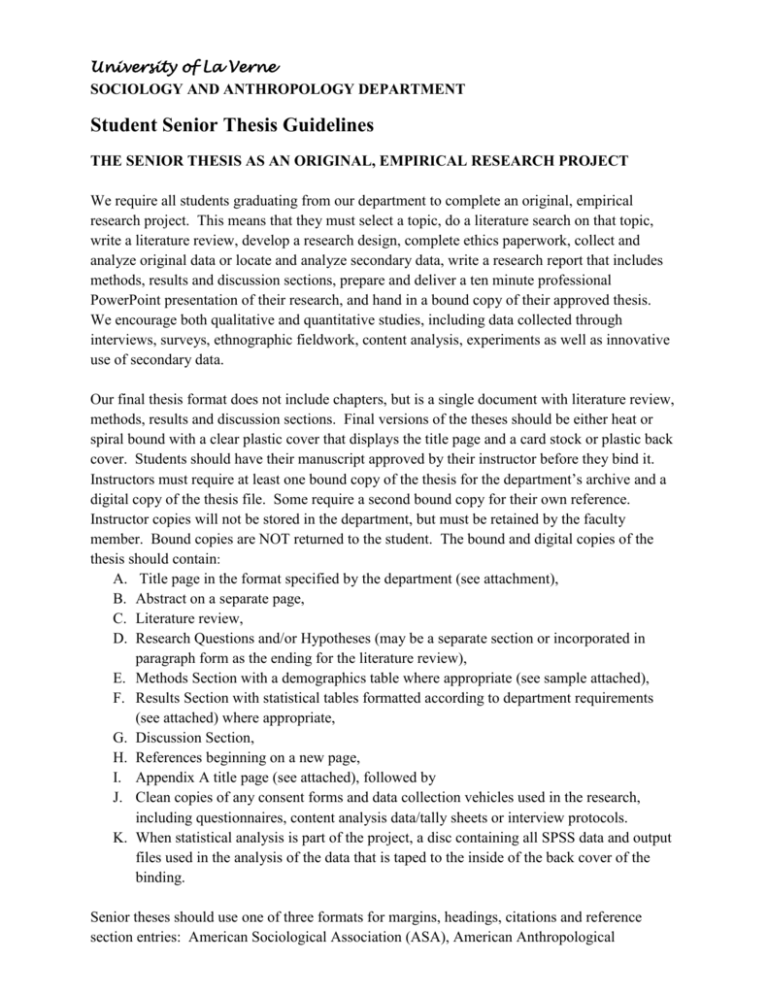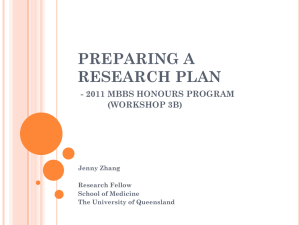Student Senior Thesis Guidelines - Sites at La Verne
advertisement

University of La Verne SOCIOLOGY AND ANTHROPOLOGY DEPARTMENT Student Senior Thesis Guidelines THE SENIOR THESIS AS AN ORIGINAL, EMPIRICAL RESEARCH PROJECT We require all students graduating from our department to complete an original, empirical research project. This means that they must select a topic, do a literature search on that topic, write a literature review, develop a research design, complete ethics paperwork, collect and analyze original data or locate and analyze secondary data, write a research report that includes methods, results and discussion sections, prepare and deliver a ten minute professional PowerPoint presentation of their research, and hand in a bound copy of their approved thesis. We encourage both qualitative and quantitative studies, including data collected through interviews, surveys, ethnographic fieldwork, content analysis, experiments as well as innovative use of secondary data. Our final thesis format does not include chapters, but is a single document with literature review, methods, results and discussion sections. Final versions of the theses should be either heat or spiral bound with a clear plastic cover that displays the title page and a card stock or plastic back cover. Students should have their manuscript approved by their instructor before they bind it. Instructors must require at least one bound copy of the thesis for the department’s archive and a digital copy of the thesis file. Some require a second bound copy for their own reference. Instructor copies will not be stored in the department, but must be retained by the faculty member. Bound copies are NOT returned to the student. The bound and digital copies of the thesis should contain: A. Title page in the format specified by the department (see attachment), B. Abstract on a separate page, C. Literature review, D. Research Questions and/or Hypotheses (may be a separate section or incorporated in paragraph form as the ending for the literature review), E. Methods Section with a demographics table where appropriate (see sample attached), F. Results Section with statistical tables formatted according to department requirements (see attached) where appropriate, G. Discussion Section, H. References beginning on a new page, I. Appendix A title page (see attached), followed by J. Clean copies of any consent forms and data collection vehicles used in the research, including questionnaires, content analysis data/tally sheets or interview protocols. K. When statistical analysis is part of the project, a disc containing all SPSS data and output files used in the analysis of the data that is taped to the inside of the back cover of the binding. Senior theses should use one of three formats for margins, headings, citations and reference section entries: American Sociological Association (ASA), American Anthropological Association (AAA), or American Psychological Association (APA) . The final copy of the thesis should be one continuous document with no extra spaces beginning with the literature review and ending with the last line of the discussion section. New pages should be begun for the title page, the abstract, the thesis document, the reference section, the appendix title page, any consent forms, and any data collection vehicles. The bound senior thesis should be accompanied by the student’s resume/curriculum vitae and a departmental senior exit survey. These should NOT be bound into the thesis itself. COURSE PARAMETERS Senior thesis taken over a single 16 week semester is a challenging task. Students who miss even a single class find themselves falling behind. If students fall behind it is very difficult for them to catch up. Students who have not made adequate progress or have missed too many classes by the week before the last day to drop courses will be asked to drop the seminar. This prevents frustrating, no win situations from developing for both student and instructor. Instructors should include a statement to this effect in their syllabi. ETHICS AND ETHICS DOCUMENTATION Faculty members are responsible for the ethical behavior of students doing research in their classes. We do not allow our students to do research projects that have more than minimal risk to either the participants or the researchers. All students should have completed both the University of La Verne and the Department of Health and Human Services ethics online trainings in their research methods courses prior to enrolling in their senior thesis seminars. If they have not, they need to complete both trainings before they begin to develop their research design. All students whose research designs include human participants will fill out the Institutional Review Board Application that is found on the IRB webpage on the La Verne website: http://laverne.edu/academics/institutional-review-board/. Students doing projects that do not involve special populations must complete only part A of the application; participants who will involve special populations such as children must also complete part B. The IRB application is retained by the instructor to document the relative risks involved in the project. Faculty members may choose to submit the application to the IRB if they are unsure about the risks involved in the project, however, it is recommended that the faculty member help the student to adjust the project to eliminate risks rather than submitting to the IRB if there is any question. IRB applications will be collected and retained by the faculty member or stored in the department for at least one year following the end of the thesis project. All projects that involve human participants except for ethnographic fieldwork require informed consent. The IRB has a sample consent form on its website that is designed to be used for all La Verne research. It has been vetted by an attorney, and contains bracketed instructions that are replaced by information specific to the study involved. Students should use this form, modified to include their information, as their informed consent form. Sections that are not relevant to the specific study (such as those referring to payment of participants) may be deleted from the form when the student’s information is inserted into the sample form. All participants must receive a complete copy of the consent form to take with them. Researchers must also retain a complete copy of the consent form with the signature of each participant. All signed consent forms will be collected and retained by the faculty member or stored in the department for at least one year following the end of the thesis project COMPONENTS OF THE SENIOR THESIS TITLE PAGE (see attached) RUNNING HEAD All pages except the title page should have a running head in the upper left-hand corner that consists of a two to three word abbreviated title along with the page number. ABSTRACT The abstract should be between 150 to 300 words with the title “Abstract” on a separate page following the title page. LITERATURE REVIEW (18-20 pages long, minimum of 20 academic references). The literature review portion of the project should between 18 and 20 pages long and should be based on a minimum of 25 academic references. The literature review should NOT have a heading at the top of the first page. Academic references DO include peer-reviewed journal articles, books, edited volumes, government documents, theses and dissertations. Web sites are generally acceptable if they have a .edu or .gov address. The literature review should describe the academic context in which the student’s project will be done, and should strike a balance between detailed descriptions of methodology and results, and the integration of information into a cohesive summary of what is known about the student’s topic(s). RESEARCH QUESTIONS AND/OR HYPOTHESES It is expected that students will have at least two to five research questions and/or hypotheses. Explanatory research that addresses two or more variables will always have hypotheses. Qualitative research that will describe a single organization, group or culture of some sort may only have research questions. Research questions and/or hypotheses may be integrated into a final paragraph of the literature review, or listed at the end of the literature review. METHODS Most studies will have methods sections that include three sections: participants, measures and procedures. This type of methods section will have a demographics table as part of the “participants” portion. See the attached sample for the table format. Ethnographic studies may present methods-related information somewhat differently, with fieldwork parameters given along with introductory information about the location of the fieldwork and demographics of the group studied, as well as the logistics of entering, observing and participating in the group, organization or community. DATA COLLECTION Students may chose to do an experiment, a survey/questionnaire, interviews, content analysis, secondary data analysis or ethnographic fieldwork. Samples should be drawn from a single, well-defined population. Guidelines for the size of the sample are based on an estimated 30 to 40 hours of data collection time, including the time to locate participants, to travel to where participants are, and to collect the data. Students who do not meet the minimum sample size appropriate for their research design will have their grades significantly affected. Content analysis samples will depend on the number of variables being studied and the time required to review the material. If a survey is used, 100 surveys are required. If interviews are used, the number required is 25 if the interview is 45 minutes to 1 hour. Shorter interviews may require additional participants If using a survey that will be passed out in university classes, students should contact faculty members in advance of the class, give the faculty member a copy of the survey and consent form, and request an appointment to distribute the survey. Faculty members do NOT have to let students distribute surveys in their classes, so students should be mindful of the need to be respectful and courteous at all times. When distributing the surveys in classes, students should introduce themselves and their study, make it clear that no one has to participate if he or she does not want to, hand out the consent forms first and collect them separately from the surveys, and be sure to thank both the professor and the students who participated. RESULTS The results section should present only results, with no interpretation, commentary or discussion. Results should be written in the proper formats for statistical analyses, including the correct numerical information. Multiple significant analysis of variance results with the same independent variable should be presented in a table (see format below). Correlations can also be presented in tabular form. Cross tab/chi square results are not usually presented in tables. Tables should NEVER be copied directly from SPSS output. All results tables must be reformatted using the department-approved formats. THE DISCUSSION SECTION The discussion section should interpret the results and discuss how they relate to previous research. Additionally, this section may include suggestions for improving the research design, and/or for future research directions,. THE ORAL PRESENTATION Oral presentations are the Tuesday nights during the last week of classes and finals week each term. They run from 6:30pm until we are finished. This is usually between 10 and 10:30pm. Student presenters are required to attend both nights and to stay for the duration of the presentations. Failure to do this affects the final grade of the student. If the number of students in senior thesis warrants, we will add addition presentation dates on the Wednesday nights of the last week of classes and finals week as well. Students may invite family, significant others, and friends to see their presentation. Oral presentations are 10 minutes in length, with two minutes set aside for questions after the presentation is over. Students must prepare a PowerPoint to accompany their presentation. PowerPoints usually include major theoretical perspectives and/or key article descriptions, research questions or hypotheses, methods and demographic information on the sample, major findings and a brief discussion. We time the presentations carefully, and photograph the students after they present. Students are asked to wear professional dress and to submit their final draft PowerPoints to their senior thesis advisors by noon on the Friday before their presentation date. It is up to faculty members’ discretion whether to accept PowerPoints after that time, and it is assumed that late PowerPoints will result in a reduced grade for the student. All power points are loaded onto the computer in the presentation room by instructors prior to the beginning of the presentation session so that there is minimal time between presentations. Students should be able to simply click on their PowerPoint icon and begin their talk. The department will host a rehearsal for the presentations each term, usually offered on the Sunday afternoon prior to the first presentation date. Instructors may require their students to attend the rehearsal. Risk and Politics: An Environmental Health Crisis in a Multicultural U.S. Neighborhood Susie Q. Student Submitted to Faculty in the Sociology and Anthropology Department University of La Verne in partial fulfillment of the requirements for the degree of BACHELOR OF SCIENCE IN SOCIOLOGY Advisor: Kimberly Martin, Ph.D. May, 2008 All in the Family All in the Family: A Study of Intergenerational Juvenile Gang Membership Alyson N. Kantor A Senior Thesis Submitted to the Faculty in the Department of Sociology and Anthropology at the University of La Verne in Partial Fulfillment of the Requirements for the Bachelor of Science Degree in Sociology December 2011 Senior Thesis Advisor: Dr. Sharon K. Davis Table 1 Demographic Information (N=156) Variable/Values Age in years 19-21 22-24 25-27 28-30 31 and older Missing data Sex Males Females Ethnicity Euro/Asian Amerasian Afro-Amerasian Years of education None 1-2 3-4 5-6 7-8 9-10 11-12 More than 12 Vietnamese language proficiency Speak Only Speak and Read Speak and Write Speak, Read and Write Missing data English language proficiency None Speak only Read only Read and write Speak, read and write N % 9 67 57 17 5 4 5.6 42.1 35.8 10.7 3.1 2.5 59 100 37.1 62.9 138 21 86.8 13.2 14 12 23 46 20 20 22 1 8.8 7.6 14.5 29.0 12.6 12.6 13.8 .6 17 5 1 133 3 10.7 3.1 .6 83.6 1.9 82 19 2 1 55 51.6 11.9 1.3 .6 34.6 Table 9 Analysis of Variance for Television Scores and GPA by Sex (N=25) Males Females (N=12) (N=13) M SD M SD Police F 10.67 2.50 7.92 3.30 5.41* Sitcom 8.17 2.76 12.15 2.44 14.69** NYPD Blue 4.25 .87 3.38 1.45 3.23 Homicide 3.42 1.16 2.54 1.33 3.06 Cops 3.00 1.04 2.00 .82 7.18* Friends 3.00 1.21 4.15 .99 6.90* Seinfeld 3.17 1.27 4.07 .95 4.16 Home Improvement 2.00 .85 3.92 .95 28.04*** Grade Point Average 2.29 .80 2.95 .70 4.76* * p< .05, ** p< .01, *** p< .001 Table 1 Intercorrelations for Vehicle Performance Ratings (N=50) Vehicle Performance Ratings 1 2 3 1. Miles per Gallon -- -.78** -.77** 2. Engine Displacement (cu inches) -- -- 4 5 6 -.80** .33* -.77** .89** .93** -.54** .95** 3. Horsepower -- -- -- .85** -.70** .84** 4. Vehicle Weight (lbs) -- -- -- -- -.41** .89** 5. Time To Accelerate (sec) 0-60 -- -- -- -- -- -.52** 6. Number of Cylinders -- -- -- -- -- -- * p <.05, ** p< .01









